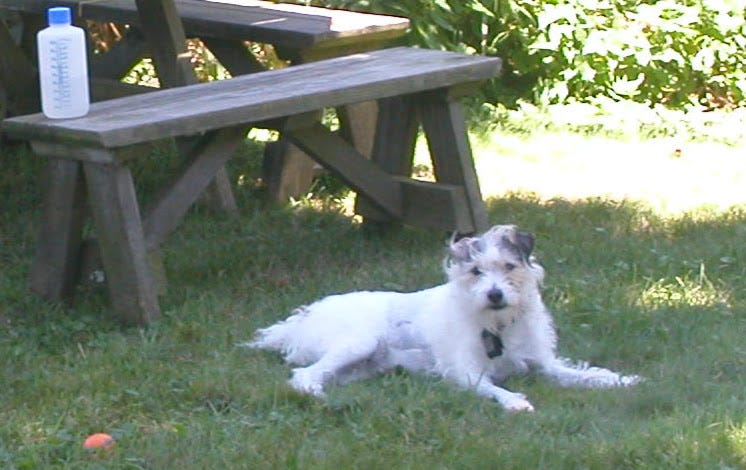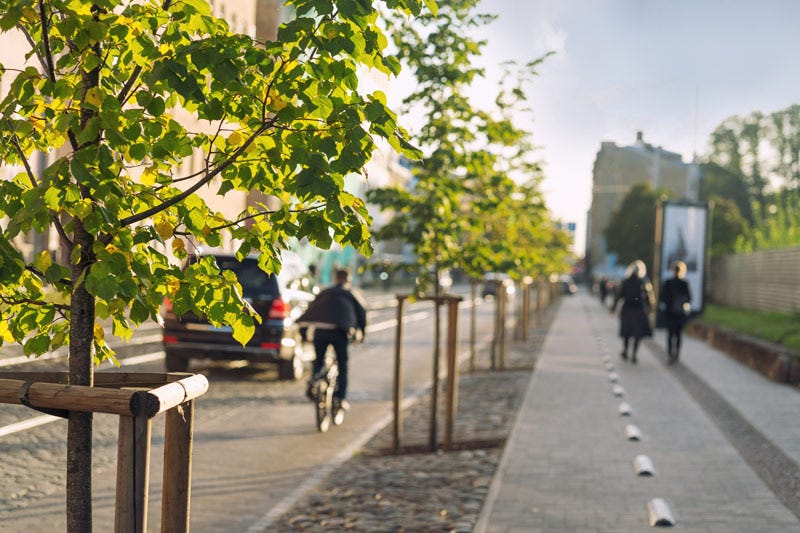Buddy valued shade and water in the short moments he rested from playing ball or researching climate issues.
We can pay to plant trees in the Amazon basin as a way to absorb CO2 and slow global warming. But recently these ‘offset’ programs have proven to be largely bogus. Maybe someday more trees in the tropics will help save the planet, but in the meantime more trees in our own neighborhood can help us save on our air conditioning bills, keep the sick and elderly cool, manage stormwater, and avoid health risks from poor air quality.
The streets and sidewalks, parking lots and playing courts around us absorb sunlight, making them hot. Hot surfaces don’t just affect those standing on them. They heat the whole neighborhood. In many towns they create a ‘heat dome’ or ‘heat island,’ an easy-to-measure area which stays persistently hotter than its surroundings - especially at night when the other surfaces cool down more quickly.
Shading asphalt and other dark surfaces with trees and greenery can prevent a surprising amount of heat. Here’s an infrared photograph taken in Melbourne, Australia, showing a 27-degree difference between adjacent shaded and exposed surfaces.

In addition to keeping residents cooler, shading the hot surfaces in our town reduces air conditioning needs, can reduce the load on our electric utility and the possibility of brownouts or rolling blackouts, and maybe lower our utility costs a little. After all, electricity needed for air conditioning rises up to 10% for each 2°F rise in temperature.
What to watch for
A line of trees like this along sidewalks, streets, playgrounds, and parking lots could be one of the most effective ways to protect our town from the heat risks that are growing each year. Here’s what those shade trees look like when we first plant them. Not much shade yet, but in a few years this street will be much cooler on sunny days.
Who’s starting to plant?
A lot happened this September. The US Forest Service awarded $1 billion in grants to nearly 400 projects to expand trees and green spaces in communities nationwide.
Columbus, Ohio has now started planting trees in targeted neighborhoods, to meet the ambitious goals they set two years ago to stop net ‘canopy loss’ by 2030 and eventually increase the overall tree coverage to 40%.
Cedar Rapids, Iowa just announced they’ve received funds from the $1.5 billion in the Inflation Reduction Act for trees to ‘reduce extreme heat, benefit health and improve access to nature.’
Kansas City, Missouri has just received a $12 million federal grant to enable the city to combat extreme heat and climate change. The city will be planting and maintaining new trees and expanding its urban green spaces. Going one step further, the city has decided to provide free trees for city residents and business owners to plant on their own properties!
There are hundreds of similar projects across the country, some new, some of long standing.
The costs and benefits of trees
Planting trees is relatively cheap, averaging a few hundred dollars each. Some of the benefits are available immediately, but it can take 9 - 18 years before the energy savings outweigh the maintenance costs. That means it’s important to use best practices in designing and installing the trees to make sure that the costs of pruning, insect control, irrigation, and erosion control stay low.
But, hey! Once it’s planted, a tree provides its benefits at very low cost for decades!
In addition to reducing our electricity bill and other benefits mentioned above, trees on or near our property can raise its real estate value (one study says up to 5%), and its increased curb appeal can raise the number of interested buyers.
What we can do
Are there recent plantings along our town’s streets, or at the edge of asphalt recreation and parking areas in our town? Shouldn’t we be seeing such evidence of climate adaptation on the part of our municipal leadership? Ask at City Hall. Tell them that there’s another set of competitive grants coming up next year from the US Forest Service, with awards ranging from $10,000 to $350,000. Applications need to be in by the end of this year!
Remember the Chinese proverb, "The best time to plant a tree was 20 years ago. The second best time is now."
LEARN, THINK, ACT
Eleven benefits of street trees in urban spaces
There’s a lot of online advice and help for those interested in planting urban trees. One technical paper, Assessing the benefits and costs of the urban forest, provides some dollar values.
Here’s a guide for applicants to the Urban and Community Forestry Grant program.







Good advice however its not simply a question of planting any tree as much as the principle of shade does apply to any tree. It is equally important that we plant native species with their ongoing synergy with wildlife and supporting native wildlife